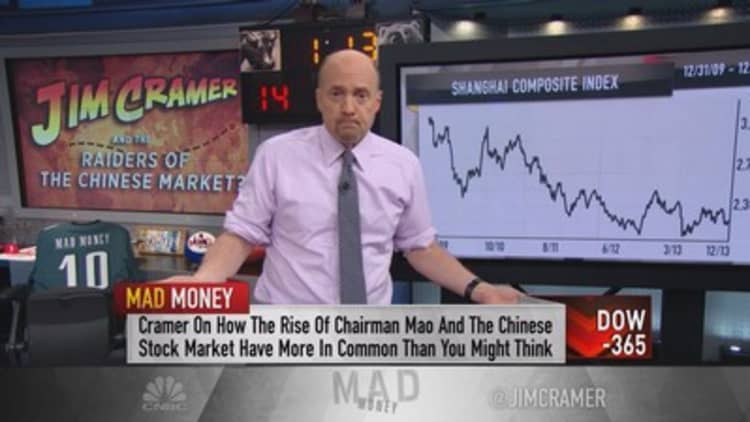
So far in 2016, the U.S. stock market has been joined at the hip with the Chinese stock market. And Jim Cramer thinks the only way to understand how China has become so important is by understanding how the U.S. got into this situation in the first place.
"This foreign index has become the tail that wags the dog of the U.S. stock market; so, how on Earth did we get here?" the "Mad Money" host asked.
From 2010 to 2013, while U.S. stocks were rebounding, the Chinese stock market declined to about 2,100 from 3,100. Everything changed in April 2014, when the Communist Party announced the Shanghai-Hong Kong Stock Connect program that went into effect that November.
This program basically connected mainland Chinese markets with the Hong Kong exchange. Suddenly even though the Chinese economy was decelerating, its stock market was flooded with foreign cash.
At the same time, the Communist Party decided to create new regulations to encourage retail investors to join the Shanghai stock market. It also relaxed rules on margin lending and allowed investors to open up multiple accounts.
Read more from Mad Money with Jim Cramer
Cramer Remix: There's no real sell-off relief in sight
Cramer: Mea culpa! I was wrong on these 2 stocks
Cramer: $300B in these bonds may need restructuring
The influx of foreign money, relaxation of margin rules and acceleration of new accounts looked to Cramer like the perfect recipe of a bubble.
"The point I'm trying to make here is that China's stock market is not representative of anything. This whole boom-and-bust cycle has been totally artificial from the start, and the whole upside move from the very beginning might need to be repealed," Cramer said.
After Wednesday's trading, the Shanghai composite fell below 3,000 and closed at 2,950. From here, Cramer recommended to watch two key levels: 2,850, which is where the index bottomed in August 2015, and 2,478, which is where it was when the Shanghai Hong Kong stock connect program began.
"Personally, I think the Chinese market probably needs to erase all of its gains since the bubble began in 2014," Cramer said,
For those investors that think the Shanghai composite needs to return to the level it was before the big flood of foreign money, the Cramer thinks the downside target is 2,500. That is down another 15 percent.
And for those that think that the whole rally needs to be repealed, that would mean the 2,100 level is significant — that could be another 28 percent down.
"At all times I prefer our market to theirs … simply because if their market goes lower, our market goes lower, too, in tandem with theirs, barring a big spike in oil or word from the Fed that it's stepping off its now ridiculous four-rate hike strategy, if you can call it that," Cramer said.
Questions for Cramer?
Call Cramer: 1-800-743-CNBC
Want to take a deep dive into Cramer's world? Hit him up!
Mad Money Twitter - Jim Cramer Twitter - Facebook - Instagram - Vine
Questions, comments, suggestions for the "Mad Money" website? madcap@cnbc.com



